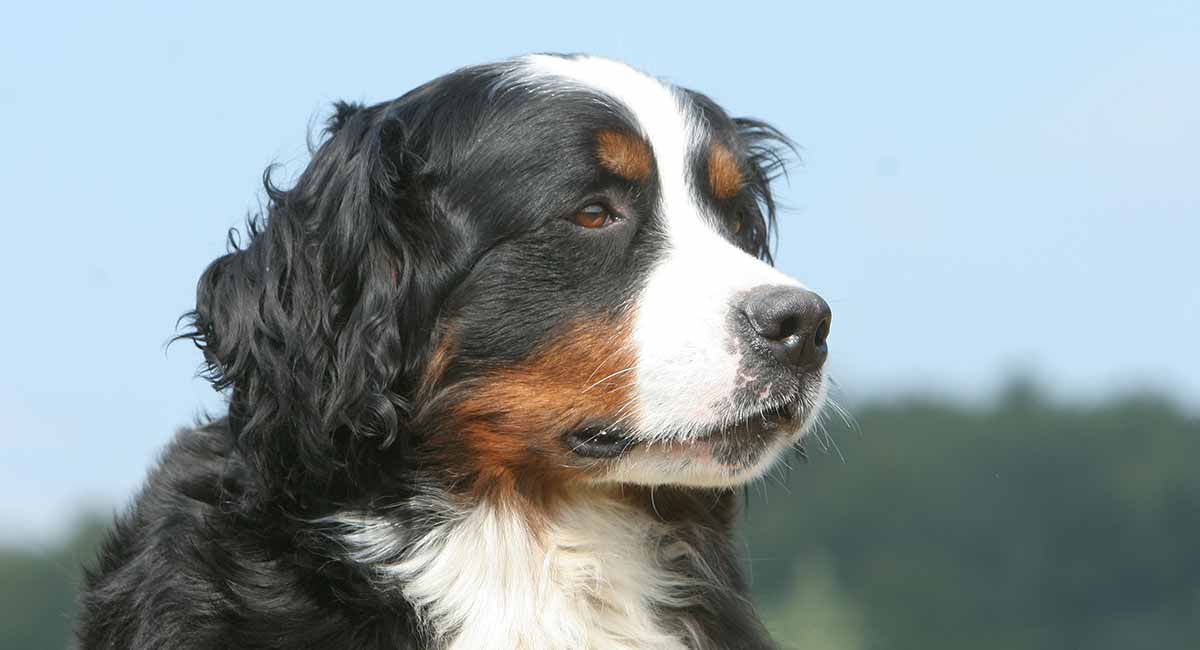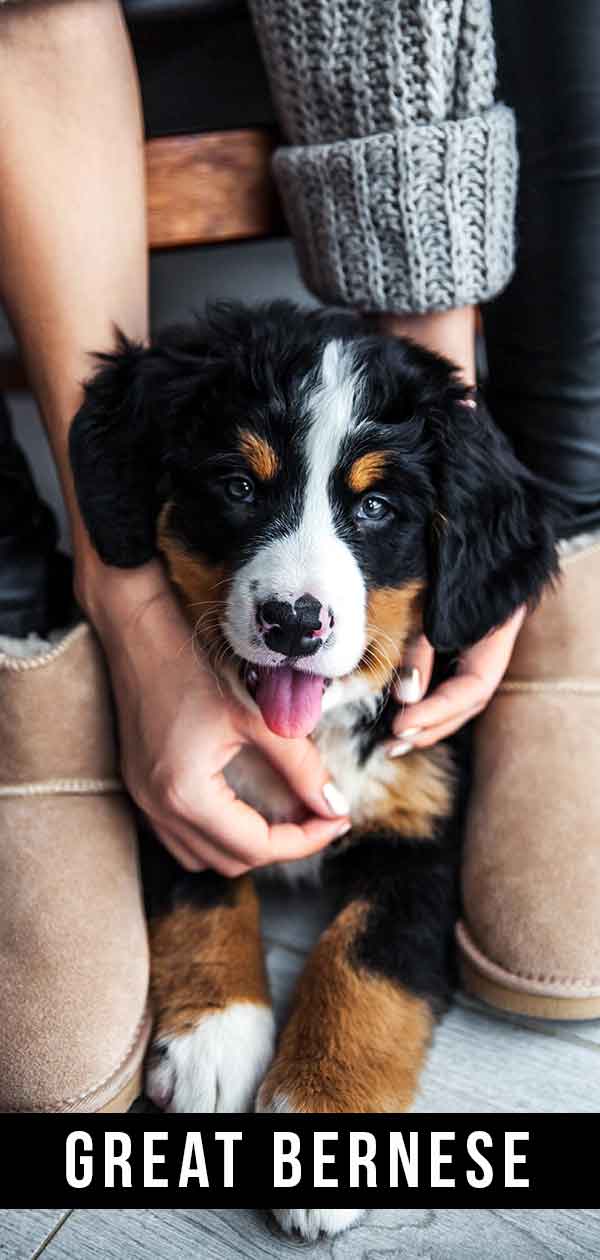
The Great Bernese is a Great Pyrenees Bernese Mountain Dog mix. This is a large dog that has a calm and patient personality, while at the same time being a good protector. They come from working roots, and are built to cope well in harsh climates and form strong bonds with their close families. However, due to their large size and high energy levels, they need lots of space to be active. The Great Bernese can also be stubbornly independant, and are prone to some uncomfortable health conditions.
Contents
- What do Great Bernese dogs look like?
- Temperament and training.
- Are they healthy dogs?
- Great Bernese puppies.
Where Does the Great Bernese Come From?
Bernese Mountain Dogs and Great Pyrenees are both large and powerful mountain dogs with thick coats. They thrive in colder climates. They are well adapted to the rigors of farm life, which can involve protecting livestock from predators and herding sheep.
The Bernese Mountain Dog comes from the farms and pastures of Switzerland, where he has worked for centuries. One of the great advantages of this working dog was his ability to pull many times his own weight, whether pulling a cart or sled. This dog was first brought to the United States in 1926.
The Great Pyrenees comes from the border between France and Spain, in the Pyrenees Mountains, where they were bred centuries ago to assist shepherds and herding dogs. Just like the Bernese Mountain Dog, the job of the Great Pyrenees was to protect and guard livestock.
Sometimes this involved patiently watching the farm animals for days at a time, and then courageously springing into action when a threat such as wolves or bears appeared.
Great Bernese Appearance
The fully grown Great Bernese is on average between 26 and 28 inches tall, with a weight between 70 and 115 pounds. The males are more on the upper end of this range and the females, being smaller, are more towards the lower end. They have hardy frames with muscular bodies hidden underneath their long and thick coats.
Their thick coat is usually straight with a rough texture, and they have a dense and wooly undercoat. They typically have a coat pattern consisting of a three-color combination among the colors black, brown, white, or rust. They have dark brown eyes, and floppy triangle-shaped ears.

Great Bernese Temperament
The behavioral traits of this dog will depend on the traits of the parent breeds, and there is no hard rule on which traits will win out, so your best bet is that you will get some combination of the traits present in both dogs. Some Great Bernese will resemble more the Bernese Mountain Dogs, while others will resemble more the Great Pyrenees. In any case, this dog is non aggressive and has a calm patient demeanor.
Their protector nature means that their greatest affection is reserved for their owners, although they still get along with other people. A playful nature and genetic heritage means that they prefer to play outside in cooler weather than indoors.
The Great Pyrenees is known for being stubborn and independent, which is a testament to its suitability for guarding sheep in harsh environments. A dog owner experienced in training can rise to the challenge of training this dog much more easily than inexperienced trainers.
The Bernese Mountain Dogs are gentle giants and can get along very well with children. They have a tendency to become extra attached to one chosen special person in their family. Their large size requires that small children should be monitored when in his presence.
Do Great Bernesees Make Good Family Dogs?
The Great Bernese love to be in the company of their family, and are really friendly with children. However, their large size can make them worthy of close monitoring when they are around very small children – little kids are easily knocked over by accident!
These dogs often get extra attached to one special person in the family, a tendency that can be traced to their Bernese Mountain Dog roots. Their sweet intuitive nature, along with their ingrained ability to guard members of their family, makes them wonderful family pets to have.
Training Your Great Bernese
The large size and high energy level of this dog means that it is supremely suited to daily outdoor exercise. A nice outdoor walk or hike in cool weather is a joy for this dog. At least 30 minutes of exercise per day is required.
Pulling children around in a cart would could also be a welcome addition to his exercise routine. The thicker coat of this dog tends to make warmer climates unsuitable for him during periods of physical exertion. That said, they can still love to lay around indoors, but because of his large size, larger homes (inside and out) are recommended to satisfy his activity requirements.
Giving this dog a means to expend its energy through exercise also boosts its mood. Not having this outlet can result in depression, which can result in destructive behavior.
In addition to exercise, giving this dog activities to do, such as involving them in regular household work, can also boost their mood. In terms of training, early socialization starting at the puppy stage is beneficial. An owner needs to be consistent and use positive methods of training.
Having patience and gentleness is key in this regard. Use a reward system such as giving treats and vocal praise and affection, which serve as good motivators. Ideally, start training from an early age and they will carry this into their adulthood and be a well-behaved Great Bernese.
Great Bernese Health
The common health concerns for the Bernese Mountain Dog which must be monitored/tested for are:
- Elbow and hip dysplasia
- Certain cancers – such as immune system cancer
- Blood problems
- Eye problems, and
- Bloat − a serious stomach condition that occurs suddenly and is life-threatening.
Regular hygiene requirements include checking the ears for infection, and brushing the teeth often using a toothpaste made for dogs.
The common health concerns for the Great Pyrenees which must be monitored/tested for are:
- Elbow and hip dysplasia ,
- Certain cancers – such as bone cancer
- Eye disorders as described in this study and this study ,
- Luxating patellas
- Blood problems, and
- Immune disorders.
The Great Bernese has a life span of 8-12 years. The above mentioned health issues can shorten this lifespan.
The Great Bernese, because it is a mixed breed, can have any of the health issues present in the parent breeds. So tests are recommended for the following areas: Hip, elbow, patella, heart, and blood (such as DNA tests).
In terms of the type of food to give this dog, high-quality food suitable for large breeds is recommended, and this could be store-bought or prepared at home. Be mindful of how much food to give based on the life-stage of the dog, whether he is a puppy, adult, or senior dog. Also, note that too much food can cause obesity, so keep a limit on how many reward treats are given!
A 2012 study on the obesity of show dogs reveals that Bernese Mountain Dogs are prone to being overweight.
Additional care, such as nail trimming, a good weekly brushing to remove loose hair, and regular ear cleaning are important. It’s also prudent to often brush the dog’s teeth using a suitable dog toothpaste.
Rescuing a Great Bernese
Bigger dogs like the Great Bernese can still be the victim of horrible conditions, just like smaller dogs can. Likewise, owners of big dogs can experience sudden illness, homelessness, or change of circumstances which mean they have to give up their much loved and well raised pet.
Rescuing this mix or any other dog has lots of potential to be a rewarding experience. If you would like to know whom to contact about rescuing a Great Bernese (or any other dog), local humane societies are the first place you can try.
Patience is necessary when welcoming a rescue dog into your home. Having a larger home and property to explore and play in, is ideal for this larger dog, and will help him get in touch with his instincts.
Finding a Great Bernese puppy
Pet stores and puppy mills should be off your list of places to go when looking to get a puppy. This includes many internet sites!
Don’t support industries which exploit and mistreat dogs. Most pet stores receive their puppies from puppy mills. A much better alternative is to look for a puppy at a shelter or rescue.
Whether you want a larger dog, like a Great Bernese, or a smaller dog, these places have lots of wonderful choices available for you, whether they are larger or smaller dogs, mixes, or purebreds.
Here’s an interesting fact, mixed breed dogs are generally healthier and more trainable than purebreds. It is perhaps no surprise that mixed dogs are growing in popularity. Here is a helpful guide to finding a puppy.

Rick says
Is a Bernese male puppy (12 weeks) compatible with a 2 1/2 yr. old male Great Pyrenees/Coonhound mix?
Mary says
Are these puppies/dogs acceptable with an existing Golden Retriever that is 5 years old this summer ?